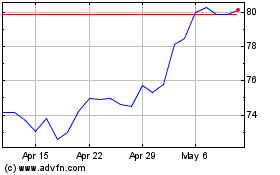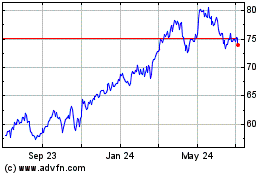AIG Logs Loss on Hedge-Fund Hit -- WSJ
May 03 2016 - 3:02AM
Dow Jones News
By Leslie Scism
American International Group Inc., under intense pressure to
boost results in its core operations to win over restive
shareholders, swung to a first-quarter loss, stung primarily by
poor performance in hedge funds and other investments.
But the global insurance conglomerate said key profit metrics
showed some improvement, aided by cost-cutting and restructuring
that it announced last year, while more aggressive steps are
getting under way as part of a Jan. 26 "strategy update."
AIG posted a net loss of $183 million, down from net income of
$2.47 billion in the year-earlier quarter when results were buoyed
by the sale of highly profitable investment holdings. A big factor
in the most-recent quarter was "the negative impact of market
volatility on investments," including a $537 million loss in market
value of hedge-fund holdings.
The quarter marked the third straight in which the dozens of
hedge funds in which AIG invests posted losses. Those holdings
totaled about $11 billion at year-end and represented about 3% of a
total investment portfolio of about $338 billion, as of Dec. 31. In
February, AIG said it would cut the hedge-fund allocation in half,
a process it has said would stretch into 2017.
AIG is among many pension funds, endowments and other large
institutional investors that have been yanking money from these
elite investment pools. Across the hedge-fund industry, portfolio
managers have let investors down for many reasons, including bad
bets on energy and currencies and a too-heavy reliance on certain
stocks.
AIG Chief Executive Peter Hancock has faced criticism over the
pace of improvement at the globe-straddling company. Next week at
AIG's annual meeting, billionaire investors John Paulson and a
representative of Carl Icahn are slated to join AIG's board. Their
nomination is part of a pact announced in February, under which AIG
is expanding its board to 16 members, and the pair of billionaires
refrained from a proxy fight and agreed to stop their public
criticism of AIG management while serving on the board.
Messrs. Icahn and Paulson will get an inside look at how Mr.
Hancock is putting in place a "strategy update" as unveiled on Jan.
26 to fight off the pair's call for the company to improve its
results by splitting into three parts. The concept behind such a
split is that AIG could escape its current designation as
"systemically important" institution by federal regulators, subject
to to-be-determined capital and other rules.
Mr. Hancock, who maintains the split isn't in AIG shareholders'
best interest, promised in the January update to reorganize AIG's
property-casualty and life-insurance operations into nine units,
more sharply cut costs, return more capital to shareholders and
potentially sell any business that underperforms.
Among good first-quarter news: AIG said it used $4 billion to
buy common stock and warrants to purchase stock, and to pay for
dividends. Also, it said in its earnings release that it had spent
another $870 million on share buybacks since the quarter ended.
Those moves get AIG off to a good start in its pledge to return at
least $25 billion of capital to shareholders through 2017.
AIG also said its "normalized return on equity" increased by
more than a full percentage point to 8.9% from the year-earlier
period. Return on equity is a widely watched benchmark reflecting
profit as a percentage of shareholders' equity in a company. On
this front, Messrs. Icahn and Paulson have complained that AIG lags
badly behind peers, some of which post returns of 12% or more.
AIG's improved return stemmed partly from cost cutting, with a
5% reduction in expenses compared with the year-earlier period.
Part of the company's net loss stemmed from restructuring that was
previously announced, including the departure of about a fifth of
senior managers.
AIG's first-quarter net loss amounted to 16 cents a share,
compared with per-share income of $1.78 in the prior-year quarter.
The insurer's operating income, which excludes realized gains and
losses, restructuring costs and some other items, fell 54% to $773
million, or 65 cents a share, from $1.69 billion, or $1.22 a
share.
Wall Street analysts expected AIG to post $1 a share in
operating income.
During the first quarter, a wide range of riskier securities
lost value amid market volatility, including asset-backed
securities and some bonds issued by energy firms. AIG said its
losses included a $341 million decline in value of holdings such as
collateralized debt obligations as well as realized capital losses
on some securities it sold from its main investment portfolio.
AIG also reported improvement in a closely watched metric
reflecting the percentage of its premium dollar that goes to pay
claims of business customers. AIG said one version of the so-called
loss ratio shrank to 64.5% in the quarter, a 1.7 percentage-point
improvement from full-year 2015. AIG has promised a
six-percentage-point reduction by the end of 2017.
Separately Monday, AIG said it was selling more shares of an
investment in China-based PICC Property & Casualty Co. Ltd.,
and would receive gross proceeds of approximately $1.25 billion.
AIG will retain a stake in the company. Mr. Hancock said the sale
is part of making AIG "learner, more profitable and focused."
AIG also is proceeding with a planned public offering of up to
19.9% of mortgage insurer United Guaranty Corp.
Write to Leslie Scism at leslie.scism@wsj.com
(END) Dow Jones Newswires
May 03, 2016 02:47 ET (06:47 GMT)
Copyright (c) 2016 Dow Jones & Company, Inc.
American (NYSE:AIG)
Historical Stock Chart
From Mar 2024 to Apr 2024

American (NYSE:AIG)
Historical Stock Chart
From Apr 2023 to Apr 2024
